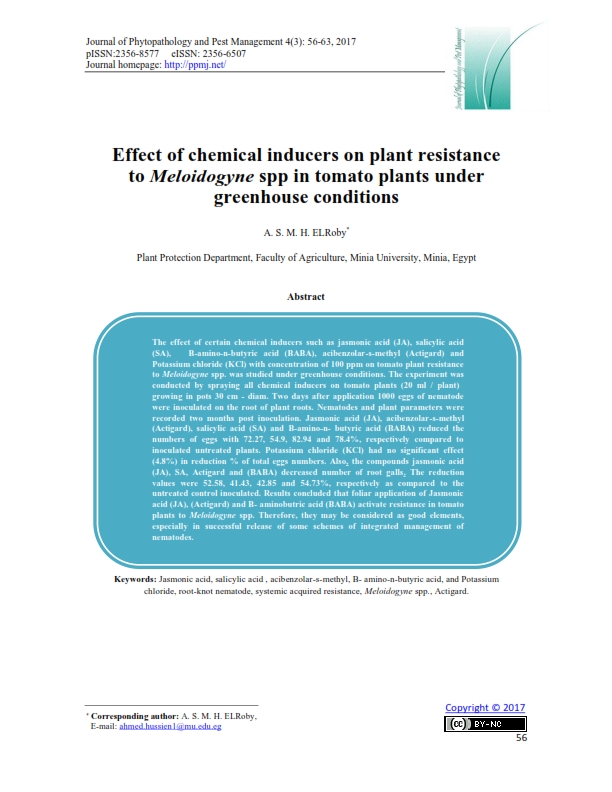Effect of chemical inducers on plant resistance to Meloidogyne spp in tomato plants under greenhouse conditions
Keywords:
Jasmonic acid, salicylic acid, acibenzolar-s-methyl, B- amino-n-butyric acid, and Potassium chloride, root-knot nematode, systemic acquired resistance, Meloidogyne spp., Actigard.Abstract
The effect of certain chemical inducers such as jasmonic acid (JA), salicylic acid (SA),  B-amino-n-butyric acid (BABA), acibenzolar-s-methyl (Actigard) and Potassium chloride (KCl) with concentration of 100 ppm on tomato plant resistance to Meloidogyne spp. was studied under greenhouse conditions. The experiment was conducted by spraying all chemical inducers on tomato plants (20 ml / plant) growing in pots 30 cm - diam. Two days after application 1000 eggs of nematode were inoculated on the root of plant roots. Nematodes and plant parameters were recorded two months post inoculation. Jasmonic acid (JA), acibenzolar-s-methyl (Actigard), salicylic acid (SA) and B-amino-n- butyric acid (BABA) reduced the numbers of eggs with 72.27, 54.9, 82.94 and 78.4%, respectively compared to inoculated untreated plants. Potassium chloride (KCl) had no significant effect (4.8%) in reduction % of total eggs numbers. Also, the compounds jasmonic acid (JA), SA, Actigard and (BABA) decreased number of root galls. The reduction values were 52.58, 41.43, 42.85 and 54.73%, respectively as compared to the untreated control inoculated. Results concluded that foliar application of Jasmonic acid (JA), (Actigard) and B- aminobutric acid (BABA) activate resistance in tomato plants to Meloidogyne spp. Therefore, they may be considered as good elements, especially in successful release of some schemes of integrated management of nematodes.
Metrics

Published
How to Cite
Issue
Section
License
Authors who publish with Journal of Phytopathology and Disease Management agree to the following terms:
- Authors retain copyright and grant the journal right of first publication with the work simultaneously licensed under a Creative Commons Attribution License that allows others to share the work with an acknowledgement of the work's authorship and initial publication in this journal.
- Authors retain copyright and grant the journal right of first publication with the work simultaneously licensed under the Creative Commons Attribution-Non Commercial License (CC BY-NC). This allows others to share the work with an acknowledgement of the work's authorship and initial publication in this journal.
- Archives of Agricultural Sciences Journal is an Open Access Journal, and articles published are distributed under the terms of the Creative Commons Attribution-Non Commercial License (CC BY-NC). Readers may copy, distribute, and display the work for non commercial purposes with the proper citation of the original work. However, the journal retains the right to exploit subsidiary rights on behalf of the authors.
- Authors are able to enter into separate, additional contractural arrangements for the non-exclusive distribution of the journal's published version of the work (e.g. post it to an institutional repository or publish it in a book), with an acknowledgement of its initial publication in this journal.
- Authors are permitted and encouraged to post their work online (e.g., in institutional repositories or on their website) prior to and during the submission process with full disclosure to the journal, as it can lead to productive exchanges, as well as earlier and greater citation of published work. Following publication in Archives of Agricultural Sciences Journal, the author should update the repository, and include a citation and link to the published work.
Click here for more information on Licensing policy
.png)




